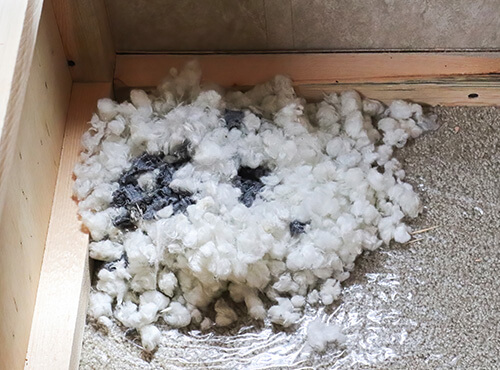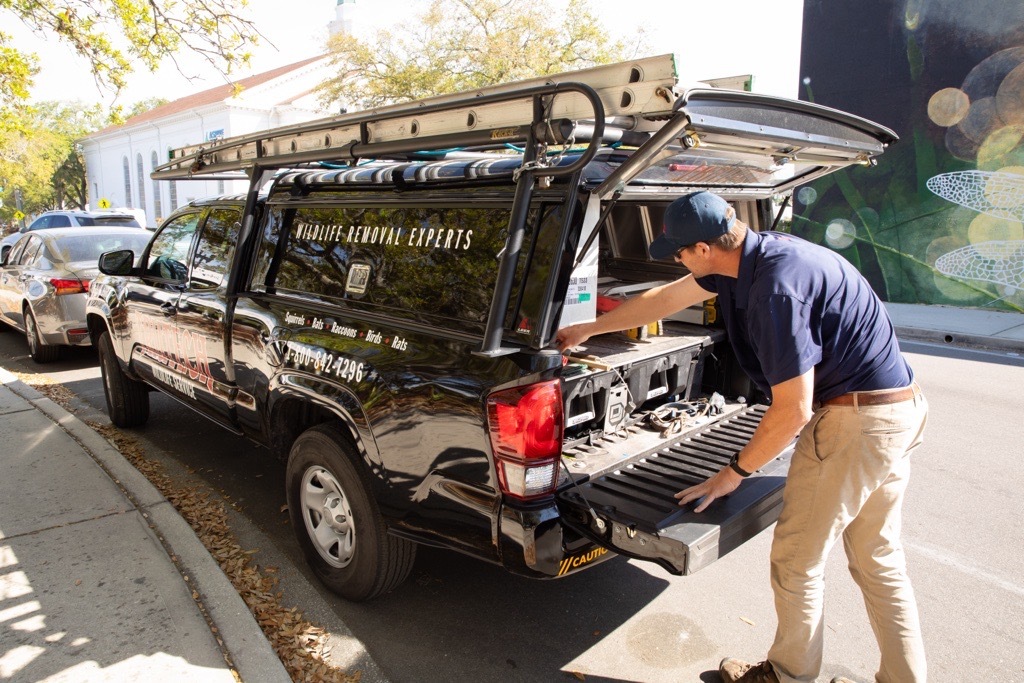The Norway rat is the most common rat pest in the U.S., but in Florida, the roof rat is the dominant rat species. The tropical climate, miles of coastline, and agricultural facilities like cow-calf operations, hog farms, and citrus groves provide ideal conditions for the palm rat to thrive.
The most common signs of rats
Roof rats make distinctive noises when active at night. Squeaking, squealing, chirping, chattering, purring, and grunting are a few of the sounds a roof rat can make. The noises become incredibly annoying when you try to fall asleep, and your local rat colony is just beginning its nesting and feeding activities for the night.
Roof rat droppings or feces are usually about ½” long and have pointy ends. If the droppings are moist and soft, they are fresh. They are old if they are hard and dry or easy to crumble. Both are unsanitary. Adult roof rats can leave fifty or more droppings every day.
Roof rats, like other rodents, have teeth that continually grow throughout their lifetime. The larger their teeth get, the more painful. Roof rats will chew and gnaw on any material to keep their teeth short to avoid this pain. They can chew through wood, plastic, vinyl, fabric, etc. It is likely due to rat activity if you see gnaw marks on furniture, baseboards, wires, or anything else.
Roof rats leave a strong, musky odor in areas where they are active. Much of the odor results from urine trails, which they leave everywhere they go. The stronger the smell, the larger the infestation.
As roof rats travel through your house, they’ll leave rub marks against the baseboard and the wall.
Roof rats tend to avoid humans and stick to areas close to their nests, staying within 100 feet of their nests. But if they leave behind evidence you will notice.
Some of the most common physical evidence you will find is rat droppings along travel routes, rub marks against walls, ripped up food packaging, and damage to the insulation.
Some signs of a rat infestation include power fluctuations, increased energy costs, and water damage. Rats damage the essential parts of your house like electrical wiring, attic insulation, exterior walls, and plumbing.
Where do rats live?
Roof rats got their name because they are excellent climbers. They are often seen on roofs, attics, trees, walls, trusses, and beams. Roof rats are usually part of a colony.
Roof rats got their name because they are excellent climbers and prefer to nest above the ground (palm trees, citrus trees, etc). They are often seen on roofs, attics, trees, walls, trusses, and beams. Roof rats are usually part of a colony. If they can’t find a way to shelter up high, they will build nests in wood piles, basements, clutter, or shrubs. They prefer to have a roof of some kind over their heads.
If they can’t find a way to shelter up high, they will build nests in wood piles, basements, clutter, or shrubs. They prefer to have a roof of some kind over their heads.

Roof Rat Behavior
Understanding how roof rats operate inside your house can assist you in identifying a rat infestation.
Nocturnal Activity
Roof rats are nocturnal, meaning they are most active at night. As soon as the sun goes down, roof rats start foraging for food and sometimes travel several hundred feet seeking food to eat and store. They like to hoard the food they find so that they can access it at any time. Roof rats prefer to eat in spots where they feel sheltered or hidden.
Roof rats are nocturnal, meaning they are most active at night. As soon as the sun goes down, roof rats start foraging for food and sometimes travel several hundred feet seeking food to eat and store. They like to hoard the food they find so that they can access it at any time. Roof rats prefer to eat in spots where they feel sheltered or hidden.
Social Behavior
You likely won’t see them, but colonies of roof rats may consist of ten or more rodents. If you happen to see a roof rat during the day, it may be because the colony is too big, and they can’t all fit in the nesting area simultaneously. Socially, roof rats will segregate themselves, forming a hierarchy where the more dominant ones get the better living area and food. The less dominant roof rats get the leftover food and nesting areas.
Roof rats only live for one year, but in that time, they can reproduce at least three times. Females have between five to eight pups per litter. One female roof rat can produce fifteen babies a year. Each female pup is ready for breeding within three months after birth, so a colony will continue to grow.
Diet
More roof rats mean it takes more food to feed them. Roof rats are omnivores, meaning they eat almost anything, including plants and animals. They would likely choose fruit, nuts, and seeds over other foods if given a choice. They don’t travel more than 300 feet from their nests for food, so if they can access pet or human food, bird seed, or leftovers in the garbage, they will take what they can back to their hiding spots.

How to Get Rid of Roof rats
There are several effective methods for getting rid of Norway rats, all of which should be done by trained professionals because they know the correct methods to address infestations. There is rarely just one rat in the area. Additionally, there is a risk of worsening the infestation if initial methods do not work. Professionals know how to eliminate an infestation the first time successfully. Below are some examples.
Rat Trapping
The size of the infestation determines the number of traps to use and the right bait. Snap traps are usually the first line of treatment. One trap for an infestation of twenty will not go well. Even with the correct number of traps, the process can take up to two weeks.
With both traps and stations like those detailed below, expect Norway rats to take several days to adjust to something new in their environment. Professionals recommend placing bait traps somewhere between the rats’ nest and food source, but not directly in their path. Place them along baseboards or near burrows.
Baits for Norway rats can include tiny portions of peanut butter, meat, chocolate, gummies, cheese, or fruit. Because rats are omnivores, they are not picky eaters.
Prevent Roof Rat Infestations
Setting baits and traps without implementing exclusions means you will soon have another rat infestation. Exclusions are what keep roof rats from entering your home in the future.
Exclusions are best when done by a professional who can adequately seal every entry point ½” or larger with heavy-duty materials that the roof rats cannot chew through, like concrete or thick metal. For smaller or harder to reach areas, caulk buttressed with hardware cloth or galvanized steel mesh will stop roof rats.
Bait Stations for Ongoing Rodent Control
With larger infestations, bait stations may be a better option. It may take over two weeks to eliminate all the Norway rats in your house. Bait stations are boxes that allow rodents to enter. Once inside, they consume toxic bait. Most Norway rats do not leave the box, but if they can, they carry the toxic materials back to their nests, where other rats will also consume them.
